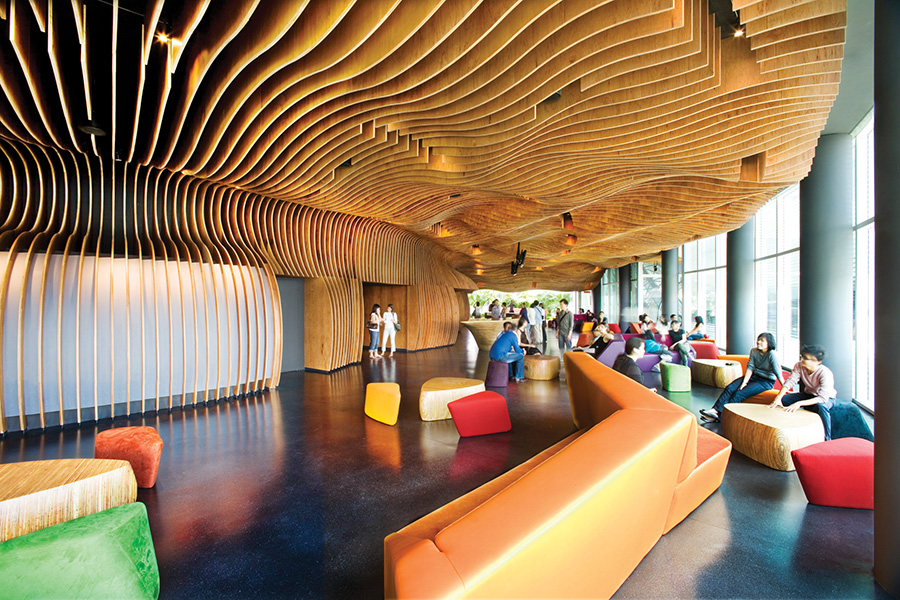Biophilic Design has entered the shopping centre world! It’s all about connecting with nature and when we do (in a shopping centre), it increases dwell-time and the retail spend, with significant influence on the MAT…
Biophilic Design is a term often banded around in meetings and misused in discussions and used as a term that means ‘greenery’ or a single nature inspired installation within a setting.
However, when Biophilic Design is understood well, communicated throughout the project team and effectively adopted as an approach to design, it not only enhances the shopper’s retail experience but also positively impacts dwell times, brings in new foot traffic, reduces energy costs and boosts the mood and performance of teams working within our retail centres.
Biophilia is the inherent human inclination to affiliate with nature that even in the modern world continues to be critical to people’s physical and mental health and wellbeing (Kellert and Wilson 1993, Kellert 1997).
To put it simply – biophilia defines our innate need to connect with nature.
Close your eyes and imagine yourself in your favourite place…
Where did you visualise? Was it inside a building with no views of nature, where you are squinting under the artificial lighting and your eyes are agitated by the stuffy air conditioning?
I didn’t think so.
With our urban populations spending up to 90% of their days indoors, the need for us to reconnect with nature is stronger than ever. I see three compelling reasons to reconnect: our physical and mental wellbeing, our understanding of our local ecosystems and our responsibility to our environment. If these three aspects can be achieved while also returning better retail metrics for our shopping centre owners and tenants, then why is Biophilic Design not at the core of every centre’s vision?
A truly biophilic project needs to be designed to include elements that nurture our innate human-nature connection. This can be done through an in-depth exploration into the project with the full project team to investigate and understand the project’s biophilic potential.
Our need to connect with nature is not only satisfied through incorporating environmental features such as water, light, air and plants into the project but also through careful consideration of Light and Space, Natural Shapes and Forms, Natural Patterns and Processes and our evolved Human–Nature relationships. These interventions, attributes or features can not only be seen but also heard, felt and even smelt.

Designing for better views, specifying natural materials, colours and textures, and connecting to local ecological landscapes either directly or indirectly are integral to good shopping centre design.
In order for benefits to be derived from this approach to design, it’s critical that the project is considered like a living ecosystem – with interrelated elements that are connected and allow for sustained and frequent contact with nature.
When considering interventions for a project these elements need to be connected, complementary and integrated with the whole environment. When considering the interior and exterior and those magical spaces in between of a retail centre, it is helpful to see them as connected interrelated parts but first and foremost consider the land pre-development and how your project can reconnect both shoppers and workers to their unique local landscape to evoke a sense of place and give a sense of meaning, purpose and delight. The 2016 World Green Building Council (WGBC) report on health, wellbeing and productivity in retail stated that a design approach that connects the retail establishment with the culture and ecology of the local area can encourage feelings of wellbeing. Feelings of wellbeing enhance and deepen experiences. Research states that people have a strong physical and psychological need to identify with the places they live and work in, which generates feelings of both safety and security.
While there is currently no metric per se for Biophilic Design two existing frameworks are valuable for reference and guidance. These are the Terrapin Green 14 patterns of Biophilic Design and Stephen Kellert’s ‘The Practice of Biophilic Design’ framework.
Considerable academic research backs up the theory that Biophilic Design positively impacts retail metrics, demonstrating a positive impact on dwell time, price acceptance and the distance that shoppers are willing to travel for their retail experience.
It has been proven that for every 1% increase in dwell time there is a corresponding 1.3% increase in spend. Considering this, investment in Biophilic Design at the offset of a project makes financial sense. Unlike bolt-on approaches to sustainability this does not need to put a strain on your project’s budget but needs to be integrated within the design process and considered from the beginning.
Designing for better views, specifying natural materials, colours and textures and connecting to local ecological landscapes either directly or indirectly are integral to good shopping centre design.
If direct contact with natural greenery is implemented within retail centres, then not only will shoppers and staff reap the benefits of direct contact with nature but the centre will also be gifted with some benefits. These include better air quality, natural shading, and the potential to decrease the amount of energy required for cooling by sheltering the outer fabric of the building – thereby reducing the energy costs within the centre.
The tangible benefits of daylight via skylights was proven back in 1999 in a report by the Californian Board for Energy Efficiency, which stated that skylights were found to be positively and significantly correlated to higher sales – on average, a non sky-lit store would have a 40% increase in sales through the addition of skylights. The research report goes even further to state that “daylighting has as much explanatory power in predicting sales as other more traditional measures of retail potential such as parking area, number of local competitors and neighbourhood demographics”.
In a more recent consumer study of biophilic store designs, the results clearly demonstrated that higher preference ratings were given to streets with larger trees – they added value to the shopping experience and customers felt these shopping precincts were worthier of their money. When participants were shown greener retail settings, they indicated that an acceptable price to pay was up to 20% higher than in a conventional setting.
Biophilic Design is supported by financial retail metrics and demonstrates clear value in terms of savings and increases in revenue for retail centres while also playing a significant role in influencing the social behaviours of communities. Studies indicate less mental anguish, reduced feelings of hostility and reduced crime rates as the social benefits of Biophilic Design, to name a few. In an era when centres are striving to create places that people prefer by designing for the human experience can we reconnect people not only to each other but also to their natural environment around them to create a lasting and sustained positive impact for all?





















